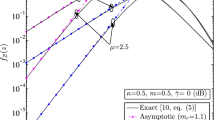Abstract
In this paper, the expressions for level crossing rate and average fade duration of two-branch selection combining are derived using the proposed matrix partitioning based method for a space-diversity system using a two-branch horizontal linear antenna array at the mobile station. It has been observed that when the antennas are perpendicular to the direction of the vehicle motion, the average fade duration is not very much dependent on the antenna spacing and is almost identical to that for independent fading except for very small antenna spacing. On the other hand, when the antennas are parallel to the direction of the vehicle motion, the level crossing rate can be reduced below the value obtained for independent fading, although the average fade duration deteriorates, especially for small antenna spacing. Numerical results are presented and compared with the existing characteristic function based methods including Gaussian fluctuation effects.










Similar content being viewed by others
References
Adachi, F., Feeney, M. T., & Parsons, J. D. (1988). Level crossing rate and average fade duration for time diversity reception in Rayleigh fading conditions. IEE Proceedings—Radar and Signal Processing, 135(6), 501–506.
Dong, X., & Beaulieu, N. C. (2001). Average level crossing rate and average fade duration of selection diversity. IEEE Communication Letters, 5(10), 396–398.
Simon, M. K. (2002). Probability distributions involving gaussian random variables—A handbook for engineers, scientists and mathematicians. New York: Springer.
Yilmaz, F. (2010). A new simple model for composite fading channels: Second order statistics and channel capacity. In 7th international symposium on wireless communication systems (ISWCS), (pp. 676–680), 19–22 Sept. 2010.
Yawgeng, A. C., & Karl, Y. T. H. (2012). On the second order statistics of correlated cascaded Rayleigh fading channels. International Journal of Antennas and Propagation, Hindawi Publishing Corporation, 2012(108534), 6.
Jakes, W. C. (1974). Microwave mobile communications. New York: Wiley.
Rice, S. O. (1944). Mathematical analysis of random noise. Bell System Technical Journal, 23(3), 282–332.
Abdi, A., & Kaveh, M. (2002). Level crossing rate in terms of the characteristic function: A new approach for calculating the fading rate in diversity systems. IEEE Transactions on Communications, 50(9), 1397–1400.
Grimmett, G. R., & Stirzaker, D. R. (2001). Probability and random processes (3rd ed.). New York: Oxford University Press.
Hiai, F., & Petz, D. (2014). Introduction to matrix analysis and applications. Berlin: Springer.
Author information
Authors and Affiliations
Corresponding author
Rights and permissions
About this article
Cite this article
Dhaka, A., Chauhan, S. & Bhaskar, V. Effect of Matrix Partitioning on Second Order Statistics of Fading Channels. Wireless Pers Commun 100, 863–875 (2018). https://doi.org/10.1007/s11277-018-5353-x
Published:
Issue Date:
DOI: https://doi.org/10.1007/s11277-018-5353-x




